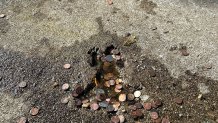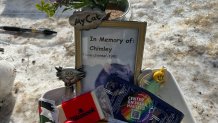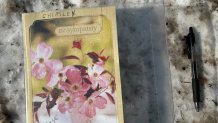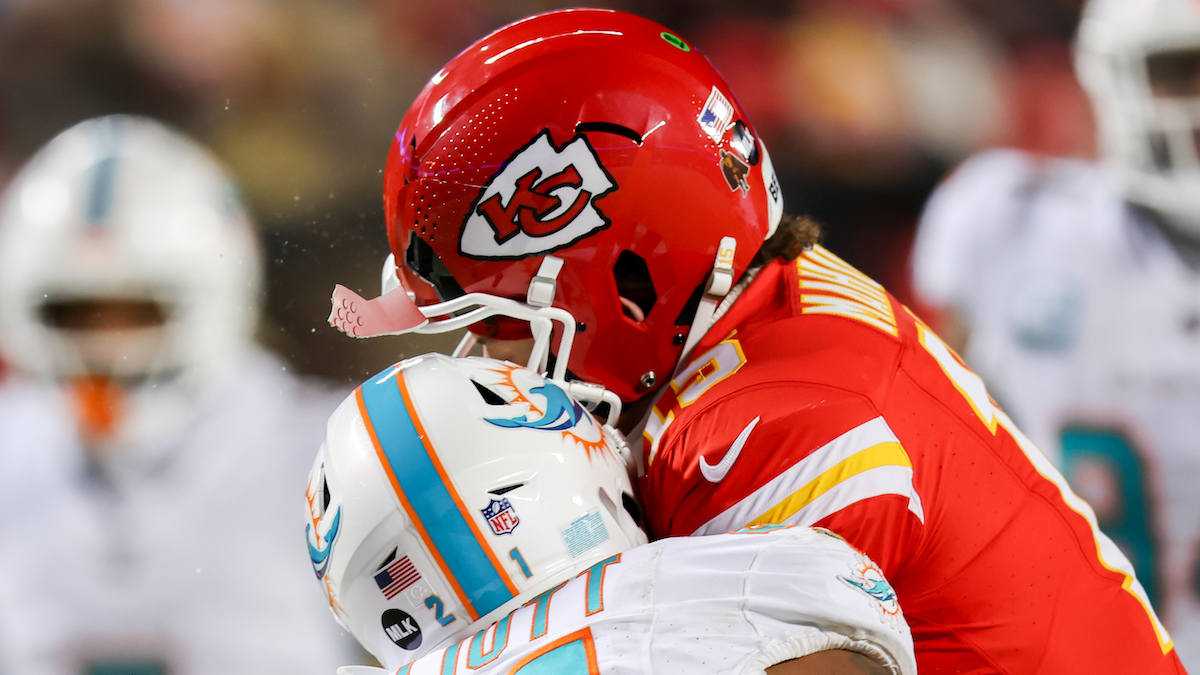A block of cheese, cigarettes, a sympathy card and more sit on the ground next to a rat-shaped imprint in a Chicago sidewalk now widely known as the Chicago "rat hole."
They're the latest items to be left outside near the viral sensation in Chicago's Roscoe Village neighborhood.
While the imprint has been in the city for years, it only recently took on new life thanks to a social media post. The rat-shaped imprint, located in the 1900 block of West Roscoe Street, has become not just a local attraction, but one now known around the country.
People referenced making a "pilgrimage" to the hole, some have left flowers and others stop for selfies. Coins can be seen on the ground as some offer up money into the shallow hole in hopes of receiving good luck.

But in a recent turn of events, people started setting up makeshift "shrines" and affectionately named the animal behind the imprint "Chimley."
"In memory of Chimley," a sign reads, alongside a quote from the rat itself in 1992, which reads "I love cheese."



Feeling out of the loop? We'll catch you up on the Chicago news you need to know. Sign up for the weekly Chicago Catch-Up newsletter here.
Despite the hole's name, the actual animal behind the imprint in the concrete remains up for debate, however.
Lincoln Park Zoo's Dr. Seth Magle, the director of the Urban Wildlife Institute, told NBC Chicago imprint may not be from a rat at all.
In what he jokingly referred to as the "most important scientific finding of maybe our lifetimes," Magle acknowledged the hype around the rat hole has taken over the conversation in Chicago, but the length of the hole "could be basically a big rat or a small squirrel."
There are other signs, however, that lead Magle to believe it was not in fact made by a rat.
"The first is when we think about what kind of animal could fall from a height and land on wet concrete. Much more likely to be a squirrel with all the time they spend in branches," he said. "We think of them as really balletic and graceful and they are. But I have seen them actually like just take a header straight out of a tree. So they, they will do that."
How would a rat have made an imprint in wet concrete with no additional marks to indicate how it got there?
"The only way to explain it being a rat is maybe if it's being carried by a hawk or something and drop, you have to make up a really complicated story to make that work," Magle said.
But that's not all.
"The second reason I think it's a squirrel is that when we think about when concrete is usually wet, it's probably gonna be during the day," Magle said. "It's probably not gonna be wet in the middle of the night. Rats are active at night."
Magle said the third factor is that some longtime residents have previously reported the imprint was actually from a squirrel.
According to some residents who live near the now-iconic street sensation, the fandom surrounding the memorable sidewalk design was unexpected.
Cindy Nelson, who has lived across the street from the imprint for over 20 years, told the Chicago Sun-Times, “I don’t want to burst anyone’s bubble or upset anybody, but it’s a squirrel."
Nelson told NBC Chicago a tree used to be located near the spot where the imprint is located.
"So there was a huge tree there originally and the people that lived here when the tree was here, you know, we kind of all just believe that it fell out of the tree," she said. "And then I just personally believe it was the squirrel that fell out of the tree. I don't know if a rat can run up a tree or a raccoon."
You might be asking, however, if it was a squirrel, what about its tail?
"I'm not totally sure whether the fur on a squirrel's tail would be heavy enough to imprint itself in concrete," Magle said. "It may have to do with how it landed. It may have to do with something else. But, you know, this is something we often see. Like, for example, it took them a long time to figure out that, like, certain animals in the fossil record had fur because fur doesn't really leave an impression necessarily the way a more dense part of a body, like a bone or muscles, would."
But that still leaves the question of how did it get away with no other prints left in the concrete? Did the animal survive?
"Squirrels are tough, but the reason that I think probably not is if it had, I would expect we would see other paw prints and stuff still in the concrete when it was sort of dragging itself off," Magle said.
There is one scenario, however, in which a happy ending could be conceivable.
"At a minimum, it probably laid there long enough to leave that impression, the rest of [the concrete] dried out," he said. "Sometimes animals, we see that sometimes with birds that hit windows, sometimes they seem like they're dead but they're stunned and they can lay there for hours before they get up and fly away. So sometimes that does happen."
Whatever it is, residents are surprised at the sudden attention -- and just how big it's gotten, with tributes, a rush of visitors and more.
Magle says he loves seeing the viral nature of it all.
"I think what it reminds us is that, no matter how deep in the city you live, we all have this deep tie, this need to be connected to nature and other species - even if it's in kind of a weird way, like look at this rat hole in the sidewalk," he said.




